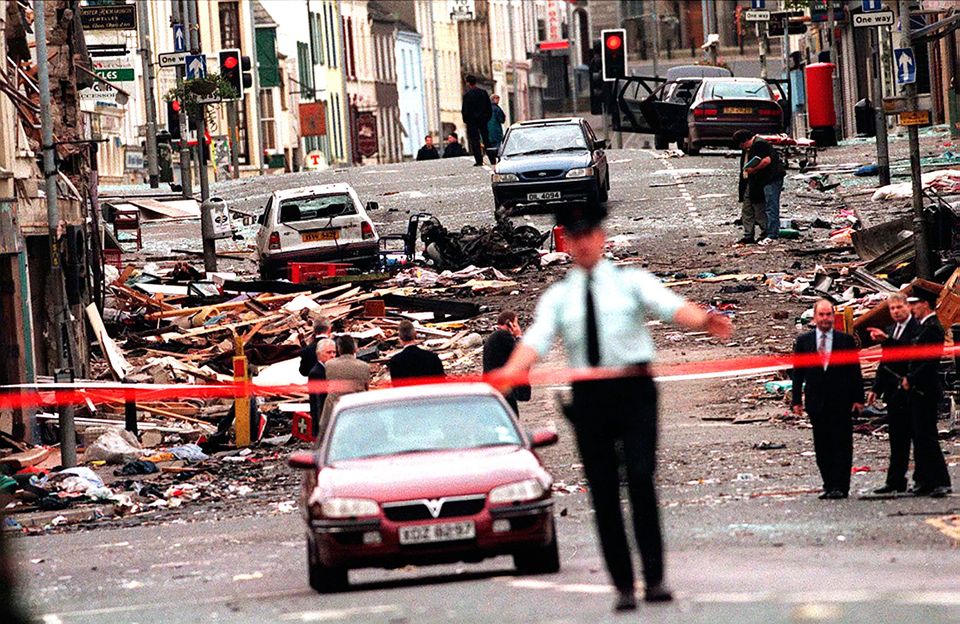Omagh town centre is distinctive. Its main thoroughfare sweeps downhill from the courthouse along the banks of the River Strule.
Cobbles give way to tarmac as High Street runs into Market Street down to the junction with Drumragh Avenue.
A bright memorial pillar reaches into the sky at the bottom of the hill. Inside is a large cut-glass heart, lit by reflections from 31 pole-mounted mirrors that send light to the structure.
One for every life lost in the bomb.
More than a quarter of a century after the Real IRA detonated a 500lb bomb in its packed town centre, the victims’ families are finally being given a voice.
The inquiry that will ultimately investigate whether the devastating events of that day could have been prevented began this week at the Strule Arts Centre.
Outside, groups of schoolchildren walked up and down the street, too young to remember an atrocity that made worldwide headlines and left a trail of devastation lingering 26 years on.
Fourteen of the victims — including unborn twins Eimear and Evelyn Monaghan — were aged 18 or below. Innocent children stolen by grotesque brutality.
Some of the victims of the Omagh bomb
On the opening day, Michael Gallagher — who lost his son Aiden (21) in the bomb and who has campaigned for answers since — said the inquiry would finally hear “the unadulterated voice of victims”.
That voice, spoken through the victims’ loved ones and those trusted to tell their stories, has been heard loud and clear this week.
Their words should shock and move all who hear them.
Paloma Abad Ramos reaching for her sister Rocio’s foot to pray over her, trying to come to terms with the awful reality that her head was all that remained.
Twelve-year-old Fernando Blanco Baselga, whose biggest wish was to “go to heaven”, murdered thousands of miles from his home city of Madrid.
Claire Hayes, joking with her brother Alan Radford as he walked out the gate for the last time to help his mother with the shopping before dying in the blast.
Read more
Toddler Breda Devine, aged 20 months, brought to town by her excited mother to buy shoes for her role as flower girl at her uncle’s wedding.
The ultrasound images projected to the inquiry of baby girls Eimear and Evelyn Monaghan, whose family would never get to welcome them into the world.
Their big sister Maura Monaghan, the 20-month-old whirlwind of joy who charmed the ‘Bonny Baby’ judges just months before her death.
Her devoted mother Avril, killed alongside her mother Mary Grimes, who was celebrating her 66th birthday that day.
Student Debra-Anne Cartwright, slaughtered on the cusp of a new chapter, her dreams of university shattered by the blast, exam results arriving on the day of her funeral.
The aftermath of the Omagh bomb on Market Street. Bereaved families are commemorating the victims at the ongoing inquiry into the atrocity
Loving mother Geraldine Breslin, apologising to her husband on her deathbed for being in the wrong place at the wrong time. Her family’s lives forever changed.
Young teenage footballer Gareth Conway, murdered while in town buying new jeans for a night out with his girlfriend and ready to embark on a career in engineering.
The scale of the evidence silenced the press room and drew tears from many of those watching.
In the face of such horror, it is understandable some shy away. The sheer range of victims makes it much easier to relate to the suffering.
To listen to the words, or look at the evidence is to absorb its pain, but we must face the feelings it evokes.
That the Omagh bomb came just months after the Good Friday Agreement adds to its cruelty. Peace promised the victims so much more.
They were looking forward to a new dawn, peace after decades of conflict; relief for those who had lived through the worst of the Troubles and hope for those whose lives spread out before them.
All that was torn apart on that hot August day in 1998 and the pieces handed to their families to carry.
Twenty-six years on, those families may be on the cusp of answers to the questions that haunted them since.
Their voices are being raised, their bravery, strength and vulnerability are all on display just metres from where evil upended their lives.
As this inquiry progresses, they should have space to tell their stories and a public willing to listen as they seek closure on wounds left weeping for more than a quarter of a century.

